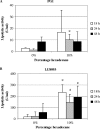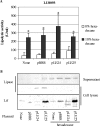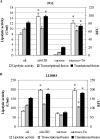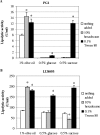Hexadecane and Tween 80 stimulate lipase production in Burkholderia glumae by different mechanisms
- PMID: 17468265
- PMCID: PMC1932709
- DOI: 10.1128/AEM.00097-07
Hexadecane and Tween 80 stimulate lipase production in Burkholderia glumae by different mechanisms
Abstract
Burkholderia glumae strain PG1 produces a lipase of biotechnological relevance. Lipase production by this strain and its derivative LU8093, which was obtained through classical strain improvement, was investigated under different conditions. When 10% hexadecane was included in the growth medium, lipolytic activity in both strains could be increased approximately 7-fold after 24 h of growth. Hexadecane also stimulated lipase production in a strain containing the lipase gene fused to the tac promoter, indicating that hexadecane did not affect lipase gene expression at the transcriptional level, which was confirmed using lipA-gfp reporter constructs. Instead, hexadecane appeared to enhance lipase secretion, since the amounts of lipase in the culture supernatant increased in the presence of hexadecane, with a concomitant decrease in the cells, even when protein synthesis was inhibited with chloramphenicol. In the presence of olive oil as a carbon source, nonionic detergents, such as Tween 80, increased extracellular lipase activity twofold. Like hexadecane, Tween 80 appeared to stimulate lipase secretion, although in a more disruptive manner, since other, normally nonsecreted proteins were found in the culture supernatant. Additionally, like olive oil, Tween 80 was found to induce lipase gene expression in strain PG1 in medium containing sucrose as a carbon source but not in glucose-containing medium, suggesting that lipase gene expression is prone to catabolite repression. In contrast, lipase production in the lipase-overproducing strain LU8093 was independent of the presence of an inducer and was not inhibited by glucose. In conclusion, hexadecane and Tween 80 enhance lipase production in B. glumae, and they act via different mechanisms.
Figures





Similar articles
-
Mutations improving production and secretion of extracellular lipase by Burkholderia glumae PG1.Appl Microbiol Biotechnol. 2016 Feb;100(3):1265-1273. doi: 10.1007/s00253-015-7041-z. Epub 2015 Oct 17. Appl Microbiol Biotechnol. 2016. PMID: 26476653 Free PMC article.
-
Complete genome sequence of the lipase producing strain Burkholderia glumae PG1.J Biotechnol. 2015 Jun 20;204:3-4. doi: 10.1016/j.jbiotec.2015.03.022. Epub 2015 Apr 4. J Biotechnol. 2015. PMID: 25848987
-
Identification, characterization and regulation of two secreted polygalacturonases of the emerging rice pathogen Burkholderia glumae.FEMS Microbiol Ecol. 2008 Aug;65(2):251-62. doi: 10.1111/j.1574-6941.2008.00516.x. Epub 2008 Jul 9. FEMS Microbiol Ecol. 2008. PMID: 18631177
-
S5 Lipase: an organic solvent tolerant enzyme.J Microbiol. 2006 Dec;44(6):583-90. J Microbiol. 2006. PMID: 17205035
-
Optimization of lipase production by Burkholderia sp. using response surface methodology.Int J Mol Sci. 2012 Nov 13;13(11):14889-97. doi: 10.3390/ijms131114889. Int J Mol Sci. 2012. PMID: 23203100 Free PMC article.
Cited by
-
The roles of the shikimate pathway genes, aroA and aroB, in virulence, growth and UV tolerance of Burkholderia glumae strain 411gr-6.Mol Plant Pathol. 2014 Dec;15(9):940-7. doi: 10.1111/mpp.12147. Epub 2014 May 23. Mol Plant Pathol. 2014. PMID: 24754446 Free PMC article.
-
Exoproteome analysis of Pseudomonas aeruginosa response to high alkane stress.Arch Microbiol. 2024 Jan 4;206(1):51. doi: 10.1007/s00203-023-03749-9. Arch Microbiol. 2024. PMID: 38175208
-
Production, purification and biochemical characterisation of a novel lipase from a newly identified lipolytic bacterium Staphylococcus caprae NCU S6.J Enzyme Inhib Med Chem. 2021 Dec;36(1):248-256. doi: 10.1080/14756366.2020.1861607. J Enzyme Inhib Med Chem. 2021. PMID: 33327795 Free PMC article.
-
Strategies for Improvement of Lipid Production by Yeast Trichosporon oleaginosus from Lignocellulosic Biomass.J Fungi (Basel). 2021 Nov 3;7(11):934. doi: 10.3390/jof7110934. J Fungi (Basel). 2021. PMID: 34829221 Free PMC article.
-
Polysorbate 21 Can Modulate the Antibacterial Potential of Two Pyrazol Derivatives.Biomolecules. 2022 Dec 6;12(12):1819. doi: 10.3390/biom12121819. Biomolecules. 2022. PMID: 36551246 Free PMC article.
References
-
- Balkenhohl, F., K. Ditrich, B. Hauer, and W. Ladner. 1997. Optisch aktive Amine durch Lipase-katalysierte Methoxyacetylierung. J. Prakt. Chem. 339:381-384.
-
- Baneyx, F., and M. Mujacic. 2004. Recombinant protein folding and misfolding in Escherichia coli. Nat. Biotechnol. 22:1399-1408. - PubMed
-
- Bredholt, H., P. Bruheim, M. Potocky, and K. Eimhjellen. 2002. Hydrophobicity development, alkane oxidation, and crude-oil emulsification in a Rhodococcus species. Can. J. Microbiol. 48:295-304. - PubMed
-
- Churms, S. C., E. H. Merrifield, and A. M. Stephen. 1983. Some new aspects of the molecular structure of Acacia senegal gum (gum arabic). Carbohydr. Res. 123:267-279.
-
- Coster, H. G. L., and D. R. Laver. 1986. The effect of temperature on lipid-n-alkane interactions in lipid bilayers. Biochim. Biophys. Acta 857:95-104. - PubMed
Publication types
MeSH terms
Substances
LinkOut - more resources
Full Text Sources
Other Literature Sources

